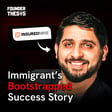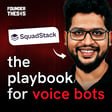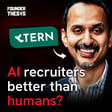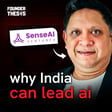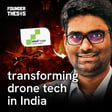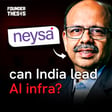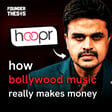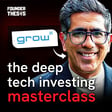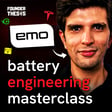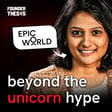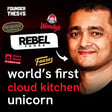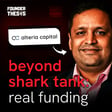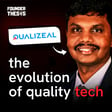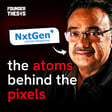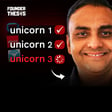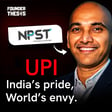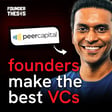Become a Creator today!Start creating today - Share your story with the world!
Start for free
00:00:00
00:00:01

Creating a crypto ecosystem for the masses | Ramkumar Subramaniam @ GuardianLink
The world of cryptocurrency is currently going through the transition from being something for hardcore enthusiasts to being a mass market technology, and one of the companies aiding that transition is GuardianLink. Ramkumar has been an early participant in the cryptocurrency revolution, having entered this space 7 years ago, and in this fascinating conversation, we learn about how the space has evolved to reach where it is today.
Insights shared:-
- How the technology behind crypto works
- Smart Contracts and understanding ‘the merge’ in ethereum
- Real world applications of Crypto
- Monetizing NFTs through gaming
For bonus content related to the episode, head over to Thepodium.substack.com
Transcript
Introduction to GuardianLink and NFT Ecosystem
00:00:00
Speaker
Hey guys, this is Ram Kumar here, founder and CEO of GuardianLink. We are an NFT ecosystem company. Glad to be here on this show.
00:00:19
Speaker
There was a time in the late 90s when if you wanted a connected computer, then you would need to have a modem in which you would have to plug in your phone line and dial a number to connect with another computer. Today we live in a hyper-connected world and every device is connected to the internet by default, requiring very little technical know-how.
00:00:38
Speaker
The world of cryptocurrency or decentralized finance is also currently going through that transition, from being something for hardcore enthusiasts to being a mass market technology.
Ram Kumar's Entrepreneurial Journey
00:00:49
Speaker
And one of the companies aiding this transition is Guardian Link. In this episode, your host Akshay Dutt is talking with Ram Kumar Subramanian, the
00:00:57
Speaker
crypto pioneer and the founder of Guardian Link. Ram Kumar has been an early participant in the cryptocurrency revolution, having entered this space seven years ago. And in this fascinating conversation, we learn how the space has evolved to reach where it is today. Listen on, and if you like such insightful conversations with disruptive startup founders, then do subscribe to the Founder Thesis podcast on any audio streaming app.
00:01:29
Speaker
I was born and brought up in Chennai, so I went and done my entire schooling and engineering in Chennai. So my mom was a housewife and my dad was an entrepreneur. He passed away a couple of years back and he had been a great inspiration for me to get into entrepreneurship. He was into manufacturing, but not about electrical parts. During the 90s that was IT, right?
00:01:50
Speaker
On my mother's side, the entire family has a legal background. My granddad is a high court judge and my aunt and all of them are lawyers and stuff. So it's either one of these two choices. Is it good legal or entrepreneurship? I chose entrepreneurship. So after my engineering, I just wanted to have some job experience. So I went ahead and worked somewhere. I worked six months and then I realized this is not what I should do. I think
00:02:12
Speaker
not meant for this. That's how I got into entrepreneurship and the first entrepreneurship journey started with working with one of my very close relatives. He's been a mentor for me and whatever I need to discuss about entrepreneurship, I used to talk to him about it right from my childhood and he decided to go ahead and try something new which is more into consulting and stuff like that. He had a very successful IT company and then he decided he'll get into consulting and then I requested why didn't I go ahead and work with you and I want to learn entrepreneurship. It is more
00:02:40
Speaker
And this was like building software for companies or like what exactly? It was more of a consulting where we go ahead and incubate a company and we work with them right from ideation to actually implementation of the project and help them run the business itself. So that's where I learned sales and stuff like that. We also in certain cases, we went and acquired firms and then we took it to them for further expansions and acquisition and stuff like that.
00:03:08
Speaker
So that's how I got into entrepreneurship. And yeah, co-founder, what was his background like? He ran an IT company, right? His name is Sandeel Igham. So he's been a mentor for me for a very long time and he ran an IT company, it's called Rails Factory. It was a very successful IT firm based out of Chennai and they were working with customers across the globe. So therefore he had that track record to actually go and sell this kind of a service. I mean, otherwise without a track record, how would you convince someone that we will incubate you and we will
00:03:36
Speaker
Or probably he had the funds also to go and acquire companies and build them up. He had the funds and he had the will also to do that. And I think I learned a lot from him. So what kind of sales were you doing? Was it sales at the portfolio companies that sales for those portfolio companies?
00:03:52
Speaker
Yeah, there are multiple portfolio companies, each one into, there was one portfolio company into food delivery. So this is way back before Spiggy and all that was a thing, right? And then there was another one, which was into movie rentals and online book rentals. And then there was another one, which was into edtech. So I was pretty much doing sales for all of these three. And we had to do sales because we need to make sure this company, whichever we took over, it has to do better. So I had to take that part. Yeah.
00:04:17
Speaker
And you had a small stake in this business or was it like an equal stake? You're obviously a junior partner here, right? I had a small stake. I had a small stake and I don't think I worried about stake during the time. I wanted to learn how this thing works. So for me, every day was a learning opportunity and I learned a lot of stuff. And we did almost like an exit after two years because he wanted to do something else.
00:04:40
Speaker
And every other firm that we took over, we went ahead and helped them either raise funds or go ahead and stabilize their business. So we took an exit from there. And that's when second half of my entrepreneurial journey started. Okay. So tell me
Exploring Blockchain Early Days
00:04:55
Speaker
about that. So you're what, by this time, 23, 24 or something like that? I guess I was around 25.
00:05:05
Speaker
I was wondering what should I do. So there is my current co-founder Kamesh who is a good friend of mine. We used to work together because he used to run a social media agency and stuff and then we used to work with him.
00:05:18
Speaker
And he always talks about entrepreneurship, right? He's a hardcore entrepreneurship guy who lives and reads entrepreneurship. And we used to meet often and talk about what can be done and stuff like that. So we wanted to get into IT and we want to get into the next cutting edge tech. And it was a six month discussion probably. I was trying to figure out what should I do next. And then I also had my own.
00:05:42
Speaker
think that I used to do some online consulting and stuff like that. So I was quite busy. He was busy with this thing and stuff. So why did we go ahead and explore cutting it stuff? And we thought, let's talk to someone who's into cutting it stuff. And we decided blockchain will be something interesting. This is like when Bitcoin was probably like less than $10 kind of price. Less than $10. So this was that like you could buy a pizza with
00:06:04
Speaker
Yeah. So no one knew what is Bitcoin back then. But what made you feel that this will be cutting edge? At that time, there were like very few people who were like believers of blockchain and Bitcoin and the whole district. So what we were trying to do is we were trying to figure out what really works, what is going to be the future in the market, right? During the time that we had an option, why didn't we get into mobile technology? Why didn't we get into building apps and stuff like that?
00:06:30
Speaker
And then there was also an option of getting into Vectek because that's when by Jews and all these really growing up, but that's going to become big in the next one to two years time. And the space will be crowded because someone will become big and everyone's going to get into it. And we are believers of, you know, hardcore entrepreneurship where, you know, you need to make money. You need to be profitable to actually do business. We didn't kind of have the attitude of raising funds and stuff like that. We were not thinking in that way. During the time, we thought what's going to be the next.
00:06:57
Speaker
future technology and what's going to change the world. And also very interestingly, we wanted to be in a space which has no competition, right? So then you can actually quickly grow. We were figuring out what is that and we used to read a lot of blogs and we used to go through various other stuff. And this, the other partner, my co-founder Arjun Kamesh, myself, and then we were figuring out who to talk to about this. That's how we met my.
00:07:18
Speaker
other co-founder Arjun and he is someone who goes to the internet and tries to find out what's the next big thing that is happening and he comes up with euphoria idea and then he says this is you know this is the one to go for right so we were talking to him and then he said blockchain is something that is becoming massive nowadays and he heard about Bitcoin through one of his client because he said no I can pay you through USD but there's something called Bitcoin I can send it to you and he started going through what is Bitcoin and what is this stuff and
00:07:45
Speaker
That's how we learned about there is a technology we had there called blockchain and stuff like that. And he said, why don't we explore this? And we decided to do that. Three guys got together, sat down for a couple of weeks, studied how blockchain works and stuff like that. And then we started a blockchain R&D firm that started building on products and kind of giving it out to entrepreneurs across the globe because there's no other firm. Probably we were five or six odd firms across the globe who know what's blockchain technology.
00:08:12
Speaker
So that's how we started. This should be around 2016. What kind of use cases were you solving? Give me an example of some projects you did. For example, wallet service. We had a ready-made wallet that you could go ahead and buy it from us and then use it right away. If you want to run an exchange and you wanted to have a custodian wallet, you want to manage that, we had a ready-made product that can be used. We had marketplaces, exchanges that you can
00:08:39
Speaker
So tell me something, how does the wallet work for an exchange? Each user gets their own wallet or does the exchange have a wallet? Just talk to me about the nuts and bolts of it. For example, a custodian wallet, right? So what happens in a custodian wallet? Let's say it's a multi-sync wallet. What's a multi-sync wallet? Okay. So a multi-sync wallet is basically a wallet where you have multiple private keys that you use to sign the wallet and that gives you access to the wallet. You can't just sign up with one.
00:09:08
Speaker
So that's like the two-factor authentication in a way. A much more technical way, a much more secure way than a two-way way, right? We used to provide custodian wallet services to exchanges. So let's say you're running an exchange and you needed a wallet and you need to manage your funds in a wallet. We have a ready-made product that is there which can be integrated to your exchange or marketplace that you run.
00:09:27
Speaker
During the time, there was probably about 100-odd coins that was there in the market and about 50-odd were Ethereum-based ERC20s, which can be supported if you run an Ethereum wallet and then there is obviously Bitcoin and then Litecoin and all that.
00:09:43
Speaker
So we used to have wallets which support all of these currencies. So you need to run nodes of each of these blockchains. And then when you run these nodes of these blockchains, you can go ahead and store that particular, let's say someone transacts in Ethereum in your exchange, you'd be able to store that Ethereum that is being transacted in your exchange. So we build these wallets that can be integrated to exchanges where multiple nodes will be running and we'll manage those nodes.
00:10:09
Speaker
And we'll also provide your friend tend to know what's your balance in Bitcoin, what's your balance in Ethereum, what's your balance in Litecoin and stuff like that.
00:10:15
Speaker
What do you mean by running a node? So basically Ethereum blockchain,
Blockchain Basics and Technology Insights
00:10:19
Speaker
right? If you take a look at Ethereum blockchain, it runs on multiple nodes and it's completely decentralized. And you can assume sort of like node to put in a very simple term, a node is sort of like a server. And if you run an Ethereum contract, a multiple transaction that goes through this particular server, and then you need to run or host a server to either manage wallets, manage the coins or to mine, or to go ahead and verify and stuff like that.
00:10:41
Speaker
So that's basically running the node, right? So we had to run a node so that you can go ahead and store Ethereum coins, Ethereum-based ERC-20 coins and stuff like that. Like a little bit of an explainer here for listeners who are not so familiar. So blockchain is basically a distributed ledger, which means that you have like a Kata or a ledger kind of a list of, there's a data set and there are multiple servers which are maintaining a copy of that. And so these servers which maintain a copy of that
00:11:09
Speaker
They all have to agree on the update, say, whatever update happens and only then the blockchain also updates data in that. And each of these servers is called a node. Am I right? So far, yes. And basically, as you told, the node is hosted by multiple parties across the globe. And obviously each are its own servers. And once, let's say, they have each blockchain has its own way of its verified. So after a particular point of consensus, it gets approved. And then whatever transaction that it gets, gets processed.
00:11:37
Speaker
So to put it in a very simple way, that's how you say it. Okay. So this was one of your products, like a wallet products. So this was like a semi-customized kind of product. I'm guessing like there would be. Yeah. Yeah. And some would come and say that, you know, I would want to just support Bitcoin. People would want to have features on build on top of it and stuff like that. So like this, we had multiple products that we built during the time. What were the other products?
00:12:00
Speaker
So we had an exchange that we used to provide basically a cryptocurrency exchange, right? Let's say you take WazirX in India, something similar to that. We had a ready-made product for that. And we had a tokenization platform, which is again a ready-made product. Before NFTs and all that, you could tokenize a real estate asset and you break down a real estate assets as multiple ERC-20 tokens.
00:12:21
Speaker
and eat square feet as a token and you can go ahead and sell out tokens like how you do a read where you go ahead and sell out the shares very similarly you go ahead and sell tokens and then you take ownership of real estate or ownership of a bond or something like that so that was the rage during that time right because people are trying to figure out case studies of how you can implement blockchain and this is a huge case where you can go ahead and give out tokens and you could take ownership of a property or you could take ownership of a bond or something like that
00:12:49
Speaker
or fractional ownership. So essentially tokens are different from coins and what is the difference between a token and a coin? So it's a very common terminology but the use case is what is different. A cryptocurrency coin, usually people refer it to it as a coin which is on a transactional manner where I can go ahead and use it as a trading asset in an exchange. The top 1000 coins right now that is there in a coin market cap.
00:13:11
Speaker
but tokens are usually used within a particular marketplace or tokenization platform where it's not traded on exchanges, it's traded within this platform and you trade or you manage within a closed platform. That's the difference between a token and a coin. But right now people have started kind of use it as a between the coin, a token and a token, a coin. So it doesn't make a difference right now.
00:13:37
Speaker
Is Polygon a token or a coin? That's a coin. It's a coin because it's traded in the market and in exchange. But some people call it MATIC token because you use that token to go ahead and pay for your cash fees. So it's used interchangeably. I was under the impression that a coin has its own blockchain and a token doesn't. Like a token is built on top of another blockchain. So that's how it started and started and then it has been used interchangeably across multiple reasons.
00:14:02
Speaker
Okay. And so what you're explaining here of tokenization, real estate investment trust, which is basically like fractional ownership of real estate where people can, they can be a trust, which can buy a property and then they can be people who can buy shares of that trust. And therefore they have a fractional ownership. So something similar can be done.
00:14:20
Speaker
through decentralized approach and basically cryptocurrency blockchain these are all decentralized finance tools so a decentralized way of doing it is to tokenize it so there's no trust as such which is run by a central body but everybody who holds a token holds a ownership of that plus some voting rights i'm guessing like that would be and there is a body that manages token
00:14:42
Speaker
And that goes ahead and says, let's say people invest in this token and that investment is used to buy out a particular real estate. And then they decide the ones who hold onto the token, they can vote what can be done on the real estate. And there is a body which majorly holds onto the token, which decides and implements what needs to be done read on the blockchain.
00:15:00
Speaker
got it. Okay. There was this whole frenzy of ICO initial coin offering. Were you providing any services there? And what is an ICO? Is it like to launch your own blockchain or is it on top of an existing blockchain? Again, it's used interchangeably, right? People used to go ahead and launch ERC 20 tokens, which is basically
00:15:17
Speaker
And what is ERC20? Do you use that term a couple of times? I want to understand that. These are tokens built on the Ethereum blockchain. If you don't have your own blockchain to have your own token and stuff, you use Ethereum as a blockchain and you create tokens on top of that. So those are called ERC20.
00:15:33
Speaker
Basically, Ethereum has the ability to execute smart contracts, I believe, and that's where all of this comes from. You can code Ethereum with certain if-then conditions and use that to create tokens. Ethereum has multiple standards, and one of those standards is ERC-20, where you can create fungible tokens. ERC-721 is where non-fungible token comes in, which probably we'll be talking about later on.
00:15:58
Speaker
What is the difference between fungible and non-fungible? Fungible means that all such tokens are equal. There is no difference between them. They are interchangeable. So, for example, fungible, let's say I go ahead and give you a 10 rupee note and then you go ahead and give me another 10 rupee note. It's all the same, right? There is no difference.
00:16:14
Speaker
But let's say if you heard about Pokemon cards, right? I go ahead and give you a Pokemon card and then you give me one. It's not the same, right? Each one has its own value. Probably you had one particular Pokemon, I had another one. So that's the actual difference between a fungible token and non-fungible token. So a non-fungible token is unique and it's on its own.
00:16:33
Speaker
Yeah, so coming back to ICOs. Yeah, what's an ICO? So ICO is the initial coin offering, right? How I use the initial public offering. So they went ahead and coined this term and said ICO is the initial coin offering, where you go ahead, as you go, you know, when any company can go public, very similarly, like shares, you determine how many coins is going to be given out, how much is going to be there in the trust, and how much is going to be spent on marketing, how much is going to be spent on various other stuff, and then how much is going to be given out to the public.
00:17:01
Speaker
and then you go ahead and offer the coins at a discount so users can go ahead and buy it and they start owning this coin now they're part of your ecosystem and whatever you do as a company out of that coin and however you're performing your coin trades in the exchange and then it value goes upside down for example someone like Polygon they didn't they launched their coin and they went ahead and went public on the exchanges probably a couple of years back they had a great use case because Ethereum had a gas fees issue
00:17:29
Speaker
And they were a solution to that. It was started using Polygon and Polygons skyrocketed, right? There were a lot of firms that went ahead into the ICOs back then in 2017. Unfortunately, about 85 to 90% of firms were majorly scams and about 10% of them were the ones who came out.
00:17:47
Speaker
I think that happens in any technology that comes in a certain crowd and kind of the early adopters taking this usage of that and then there are ones who take it forward. But 10% really came out during the bear market and those are the ones who really made difference during the 2020 boom. And I guess that's how the market has been evolved right now.
00:18:05
Speaker
Were you helping in the ICOs? Did you have blockchain as a service? An ICO is basically like someone launching their own blockchain, right? Or it could be token also? It could be token also. It could be their own blockchain as well. Yes, we've worked on a couple of ICOs as well where we went ahead and provided wallet services and then we provided the technology that is required for that.
00:18:26
Speaker
but not very keen on ICOs because you know we are always worried about the scams that were happening fortunately none of them were scammed the ones that we held out so it was a very interesting period. You spoke about the polygon token why it has value I mean I want to understand like why a coin has value if someone is doing an ICO what is gas fees and how does polygon solve gas fees and why does the polygon token have value?
00:18:49
Speaker
For example, if you take a look at Ethereum blockchain, in order to self-sustain, you would need to have a mechanism for it to have a learning model. In Ethereum, gas fees is a very crucial part of it because every time someone executes a smart contract or does an activity on the blockchain, you need a fuel, sort of like a gas fees and the gas fees is paid through ETH, Ethereum's token.
00:19:11
Speaker
And at its peak during when non-fungible market was big, NFTs were huge. A lot of transactions that happened on the Ethereum blockchain. Every second there was a transaction that was happening. And while this was going on, it was not scalable. And you had to pay a high gas fees to make sure that your transaction passed through.
00:19:30
Speaker
OK, otherwise it could take days. Probably hours and days, right? People had to figure out a solution to make sure this is solved. And Polygon was right at that time that they went ahead and built a layer 2, which is basically another layer on top of Ethereum, to make sure the consensus is taken care of.
00:19:47
Speaker
and that reduced the gap. Basically you can just pass on it through Polygon's network and pay much much lesser gas fees and have it. So there were a solution at the right time and the adoption of Polygon really grew during this period and that
00:20:03
Speaker
led to people buying more and more matic to pay for the gas and when people knew that some people are adopting matic people started going buy it how you buy your shares from the public market people built more matic started trading it and then the price went no ethereum has been a proof of work and proof of work is basically where you go ahead and let people use your server power and then basically mine the blockchain to solve complex problems such as a complex math problems such as in one way you need to go ahead and reward
00:20:30
Speaker
the network and you reward the network by giving out Ethereum tokens which people mine and on the other side there is the gas fees which is paid for the blockchain so that there is a transaction that it is part of the overall transactions that has happened on that particular blockchain and it is paid out to the people who maintain the blockchain and maintain the trust and stuff.
00:20:49
Speaker
Okay, so this Gatsby solves two problems. It incentivizes people who are putting their servers to work for the blockchain. Plus, it also ensures that anyone who wants that transaction to be updated is automatically weeding out frivolous users because you're charging a Gatsby's for it. You're charging a Gatsby's worker.
00:21:09
Speaker
Also, what happened is that initially the gas phase was very minimal, as I told you, and as Ethereum was not built for this kind of scalability, and also it's a proof of work as well, right? After a point of time, proof of work is not really scalable. That's the reason that it's going into a merger right now and it's becoming a proof of stake.
00:21:26
Speaker
So we'll unpack this. There is a lot of stuff I want to talk about it. But let me quickly finish that thought. What Polygon did is it connected this information which has to be updated on ledges from multiple sources. And so instead of, let's say, 10,000 individual updates on that ledger happening, Polygon would collate it and make it to one single update and therefore reduce gas fees for everyone. Was that what they did?
00:21:51
Speaker
Yeah, so they basically, instead of passing it on all together in that one layer one, they went ahead and passed it on in layer two, and they went ahead and did the consensus. And after a point of time, they got a consensus by the Ethereum blockchain, as you told. So they collated together and then later on passed it on.
00:22:08
Speaker
Okay, so they use a second layer of decentralized ledger, which would allow like that decentralized and robust, accurate information to be updated. And that would further get updated on the first layer, which is Ethereum. But because you would be combining so many entries together, so therefore the Ethereum cost of it would come down because now instead of 10,000 people going to Ethereum directly, they all go to Polygon and Polygon goes once to Ethereum. So that reduces
00:22:37
Speaker
Okay, so now let's talk about why is proof of work not scalable? You said proof of work is not scalable. So again, the issue that Ethereum went through because of proof of work, you have a lot of miners and then every time you need to mine and then networks become very clogged, it takes a lot of time and then you need to pay high gas fees for it to pass through and stuff. But what proof of work as opposed to what are the options for a blockchain?
00:22:58
Speaker
So you have proof of work, where basically you let people go ahead and mine your network and your server power to have a transaction approved. And then there is proof of stake, where you go ahead and let people stake your coins. And only if they have a certain number of coins be staked, then they go ahead and solve these mining issues for you. They go ahead and solve the blockchain transactions for you. These are two major proof of work and proof of stake, and the major ones that have been implemented right now. And Ethereum is moving to proof of stake.
00:23:26
Speaker
so that it's much more scalable and it's much more efficient as well compared to proof of work that is happening right now. So in proof of work, it is more server intensive and the verification of that proof takes more time and effort, therefore it is not scalable. Yes, exactly.
00:23:43
Speaker
Where is proof of stake? It's the same process that goes in. Just that it is the ones who are having a certain number of coins, obviously are the ones who are going to approve it. And you don't want to make, you don't want to be part of the network, which you want to bring it down easily because you hold onto your coin, right? So to make sure the process and everything is done. So that is the difference.
00:24:03
Speaker
So you don't have a negative repercussion if you'd like try and update some wrong information in proof of stake, because it works like consensus. So the only way for something wrong to get updated is if you have, let's say more than 51% of the supply of ethers. Yeah. So that's not possible, right? They don't allow. Yeah, it's not possible. So that is never possible. And I mean, no one could afford it also. I mean, it must be like hundreds of billions of dollars. Exactly. And the computing power of the various supercomputers that have been built across the globe, right? It is now built in a
00:24:32
Speaker
way that it could potentially take over a couple of blockchains that is currently existing and so proof of work even on a long run is on that particular reason in terms of security reasons also is not very looked on upon right now so that's one of the reasons why people are moving towards proof of stake and other options
00:24:49
Speaker
So in proof of state, you basically go ahead, you need to have a certain number of Ethereum state for you to go ahead and be part of the network. So you need to have certain number of Ethereum that you hold. That's your sort of like your entry to go ahead and be part of the network and approve the node.
00:25:05
Speaker
Okay, okay. And once you're part of the network and approving transactions, then you're also earning gas fees plus mining both in both ways you're earning. Okay, and also you have your coin stake. So, you know, obviously, the more transactions happens more, the coins value also goes up as well. Okay.
00:25:22
Speaker
Okay, so the merge is essentially when Kyria moves from proof of work to proof of stake and this would dramatically bring down the gas fees and increase the throughput and then say there's a traffic jam happening right now. So essentially the merge is like creating highways so that the traffic jam doesn't happen. And it's supposed to happen around 15th I believe. Okay, okay.
00:25:44
Speaker
So yeah, let's continue with your own journey. So like 17, 18, those ICUs were happening and you took part in a few of them and you had a wallet product. How did the business evolve from there? And what kind of revenues were you doing as a business? Like how profitable was it as a business? So you got a three member team, right? When we started all the three co-founders.
00:26:05
Speaker
on the job, around the clock working on, around after two years, since we started, we became about 300 plus employees. And that came over because we were probably one of the few blockchain companies across the globe. And especially in India. And what kind of top line were you doing, like annual turnover? This was back two to three years back, probably doing around 5 million, 4 to 5 million in that range. How much is that in rupees? So that used to be back then it was 65, 70 dollars, so about 35 crores.
00:26:35
Speaker
These 300 people that you had employed, these were largely like blockchain developers. We had to recruit the people who are really good in tech and teach them how to code. And for example, if you had to create tokens in Ethereum blockchain, you need to code in Solidity, which is Ethereum's programming language. And then we built exchanges and wallet products. So we had
00:26:58
Speaker
multiple nodes that we had to run, so you need to know multiple languages. And then we had our core language was basically Node.js and Ruby on Rails. We had people as well. So how did it proceed from there? So by 18, you were at headcount of 300 people, you were doing 35 crores, 40 crores at world revenue. Yeah. So 18 is when, sort of like the 2017-18 is when the crash started happening, the previous winter.
Adapting to Market Changes: From Crypto Winter to NFTs
00:27:25
Speaker
When RBI basically told banks that you cannot allow your customers to transfer money into Bitcoin and others. That's on the India side. But globally, the market was going through winter. So 18 to 19 end was like the winter period of crypto. And so the entire market was down. And everyone who started along with this like shutting shop. And so it made us rethink our
00:27:49
Speaker
Did your business get affected? Did you come down? It did. Our business was affected. But one good thing about us is that we were profitable from day one. And we always wanted to run a profitable company. And we had a good amount of cash reserve. We didn't really need to scale down, but we had to survive. So we figured out various other ways. We got into more of core blockchain based development where we were implementing for enterprises.
00:28:14
Speaker
on how to move into blockchain, do POCs for them on how the entire supply chain can be running on a solution like high pollution and stuff like that. So we sort of changed our strategy a bit during that period. We were more focused towards consumer-driven market where we were serving the consumer-driven market of the crypto. We kind of moved the enterprise market for those two years.
00:28:35
Speaker
So that's our sort of like the lull period and we survived the lull period. What is hyperledger? You said you were doing proof of concept for companies on using hyperledger. So hyperledger is one of the blockchain that is usually used by enterprises and we took that as a solution and usually it's... So hyperledger is just like Ethereum or like any other blockchain basically. Yeah, it's closed blockchain or like a private blockchain where you can run the node yourself and you can think around with it and you can do stuff.
00:29:02
Speaker
So hyperlegion is like open source software which allows you to create your own blockchain. Okay. And we went ahead and use that for supply chain based solutions where the entire data of what is being stored as is stored on the blockchain right now. And we went ahead and started doing that as an experiment for various enterprises.
00:29:17
Speaker
But why would blockchain have a use case here? Why not just use SAP or Oracle or any of these ERP solutions to track the data around your supply chain? Like why would an enterprise be interested in blockchain? There are two reasons. I'll tell you the technological advantages of that and the business advantage of that.
00:29:35
Speaker
The technological advantage of that is that when you go ahead and use the blockchain, you're storing data on a trustless system, right? And it is completely, you know, you don't have to worry about the data at all, right? So if someone goes ahead and tampers with it, there is a stamp saying that the data has been changed. If you're running your own centralized data management, you could tweak it as much as you want. So for example, if I use a service product right now where I hold onto a balance and let's say someone like anyone at the top wallet service providers in India,
00:30:05
Speaker
and i have 10,000 rupees as my balance and i see it today tomorrow it becomes 8,000 rupees and i have not done anything on it but my balance is gone down i would not be able to go ahead and say that someone has taken it i should probably fight against them saying that you know my balance has been gone and i have not used it for any kind of payment and they could go ahead and tweak the system
00:30:26
Speaker
anything can be done and we might need to fight against them legally. But on the blockchain, if there is a transaction that happens or if there's any change that is made, it is stored on the blockchain. Every other data has been stored on the blockchain. So that kind of immutable system was not available anywhere. And for enterprises to, on a longer scale, to provide transparency to their consumers, they need to get on to a trustless and immutable system. And that's one of the reasons they wanted to get on blockchain.
00:30:51
Speaker
2019, you're coming out of that lull. Let's continue your journey from there. Yeah. So 2019 mid, that's when DeFi and NFTs and all that were doing decentralized finance-based projects and NFTs was a thing. And we started building products based on NFTs, right? We started building a non-fungible token marketplace.
00:31:11
Speaker
And we initially gave out as a B2B solution as a product to various people who are looking for launching a non-fungible token marketplace or launch non-fungible tokens. We had a minting engine as well. So we quickly, our revenues grew up. We started hitting an 8 million ARR and our headcount also went up to about 400 people and
00:31:32
Speaker
So this is when we interview again, we were profitable, right? We were doing really well. And this is when we, we all thought my co-founders and we all decided, why don't we try our hands on B2C? We've been a B2B based firm and why didn't we get into B2C? And this is the time to do that. And.
00:31:49
Speaker
This was the end of 2020, somewhere around that time, when you decided. Yes, this was the end of 2020 and beginning of 2021. Digital collectibles were becoming a thing. As much as we become much more familiar with technology and stuff, we are slowly getting into the metaverse. We've been someone who had more on a physical presence. If someone bought a car or they went ahead and celebrated their anniversary,
00:32:15
Speaker
We'll probably go ahead and meet their friends and tell them about it. Probably meet them in a coffee shop and talk about it and stuff. But we don't do that right now. Probably the first thing that we do is we post it on social media. So the digital world is much more important for us compared to the physical world, right? So more and more digital world becomes important. The digital collectibles or digital assets in the digital world start making sense for you. So that kind of brought about the need for digital collectibles and digital artwork, digital assets and stuff.
00:32:43
Speaker
And the best way to prove ownership of a digital asset is obviously on a digital medium and also blockchain is something which is immutable and trust as I told you. Before this we could never prove ownership of a digital asset. You could buy stuff from the internet but you can't prove ownership of that. But blockchain means that you could prove the ownership of that.
00:33:03
Speaker
For example, you could buy say a photograph like a high resolution JPEG file of it, but there is no trading which can happen of it. Like anybody can make a copy of it. You can buy it and you won't be able to show the ownership. The ownership can be shown on a centralized record. It's not shown on a decentralized record.
00:33:21
Speaker
Once you start showing it on a decentralized record, your ownership never dies. Even the body which goes ahead and gives out that ownership, I mean the body that goes ahead and gives out the digital asset, it gets shut down. You could still have the ownership on a decentralized network. And once you have an ownership on a decentralized network, you can go ahead and sell it anywhere you want. That kind of revolutionized this whole concept of ownership on the internet.
00:33:41
Speaker
And initially, NFTs was more of artwork. So one question here. So we're talking of a digital asset. I think most NFTs tend to be images. So where is that image hosted? For example, I can put my images on Google Drive. But what happens for an NFT? Where is that image hosted? How does the token link to the image? And how does that connection work that this token equates to this image?
00:34:09
Speaker
So the image is stored in a file system called Interplanetary File System. It's called IPFS. It's a decentralized file system. And that's where the image is stored. And when you go ahead and relate that image to a token, you mint it on an Ethereum blockchain. You create a smart contract for that. You mint that non-fungible token. Basically, you create the non-fungible token.
00:34:32
Speaker
And the data of that data you want to have for that particular image, let's say it's going to be about someone painting about a mountain or something like that, you go ahead and write about it, you write a metadata and stuff like that, and then you have that image location, the IPFS location stored on the smart contract, and you go ahead and mint that. So that's pretty much how you go ahead and create an NFT and that's how you relate it to the image that is stored on the IPFS.
00:34:59
Speaker
And IPFS would charge some gas fees for the part of it. IPFS doesn't charge a gas fees, it is like a network fee like you pay for it and IPFS has its own coin as well and stuff like that. You pay a gas fees for the Ethereum blockchain to go ahead and mint the NFTs. Okay, so IPFS you pay like a one-time access fees to host and that is why you would want to buy that coin of IPFS to host your content, your data.
00:35:26
Speaker
Yeah, so there are two ways to handle it. So the multiple providers like IPFS, so you could go probably use how you use an AWS, you could use a subscription and use them, or you could use like a file coin or something to go ahead and pay. Okay. And then on Ethereum, it gets minted through a smart contract where there is that metadata and a link and that creates a token, which is then a non-fungible token, which is a monetizable asset, which can change in value and can be sold and it is immutable.
00:35:53
Speaker
Yeah, another important aspect over here why NFTs make sense and why digital asset ownership on the blockchain makes sense is that you could prove your prominence on the blockchain. Let's say I'm the creator and I go ahead and send it to you and then you go ahead and send it to someone and then he sends it to someone else on the secondary. So there is prominence of that. Ram sold it to Akshay for $10 and Akshay went ahead and sold it for $20 and then it has been passed.
00:36:19
Speaker
have this entire provenance being shown. So you could not show that before on the internet or any other record, right? And this again, this record is immutable. It's on across the system. So that makes it much, much more valuable. And that is one of the reasons again, so initially when NFT started, right, the artworks what filled this industry,
00:36:40
Speaker
people are getting artworks and reasoning artworks. And the artificial scarcity that was created for that artwork is what made it valuable. And that's how it worked in the real world as well, right? I guess the people incident really took the market big, right? So this is an million dollars that it was sold for that literally. Sorry, how much was it sold for? Sold for $69 million. $69 million. Okay, there's basically one artwork, one image file which was sold for that. Wow.
00:37:09
Speaker
There is this Beeple artwork called 500 Days of his Life, which went ahead and sold for about $6-10 million. And it was bought by an Indian. You might have known that, right? So it created the market and made the market big across the globe. And all of a sudden, everyone was into artwork and people created artwork and started training that.
00:37:30
Speaker
And then there was another series of NFTs that came about, right? Regenerated artwork, where you go ahead and create a base artwork, and you change how the attributes of that particular artwork. Let's say you have a monkey, and there is a bad face of that monkey. You change the color of the eyes, you put a hat on it, and you create multiple variations of that. You create 10,000 variations.
00:37:54
Speaker
And then you sell that artwork and you create this artificial scarcity and you let people know that if you go ahead and buy this NFT, which has this artwork, then you get membership to my club. And that's how projects like Bodeo.club and all that was bought. And that's how the industry turned from being an artwork to more of a club and exclusivity and stuff like that.
00:38:14
Speaker
Now the industry has moved on to become utility-driven. It has gone to a stage where from being an artwork and trading artworks and more of making money through trade, people want to understand what's the value behind this. Why should I go ahead and hold on to an NFT? There are millions of projects out there.
00:38:32
Speaker
Then as market progresses, as technology progresses, you understand that NFTs can have multiple use cases. Once you start proving ownership of an asset, you can have multiple use cases that you can build on top of it. Right now, it's more focused towards utility where if I have an NFT, I get an access to probably watch a video or listen to a podcast.
00:38:53
Speaker
or go ahead and use that NFT to play a game or use that NFT to get into a meta was even the decorating. So people started creating various utilities and NFTs as an ownership path for you to be part of that utility.
Revolutionizing Ownership with NFTs and DAOs
00:39:07
Speaker
And that's how the market market has been progress. And we as a company also have been progress.
00:39:14
Speaker
So say you have this launch card which gives you access to an airport launch. So instead of a launch card, you could have an NFT which does the same thing and that becomes monetizable and you can sell it off further when you no longer are traveling and you don't need access to launch. So that's how NFT becomes utility-based rather than just hype around the artificial scarcity. Exactly. And this NFT has all your record, what you used it for, how many times you accessed it and stuff like that.
00:39:41
Speaker
You know, even let me go ahead on the other side of real use cases of NFTs, right? You can even have an ownership of, let's say you buy a vehicle, that vehicle itself, the ownership of that can be an NFT. And every time that from the dates, it is bought to a dedicated service, when you change your parts, all of the data is on that vehicle's NFT. And you recently let the data stand for the one who is buying it from you. So.
00:40:04
Speaker
entire record of the ownership of the vehicle can be an NFT. I believe it was a very small country in Europe, which started experimenting on having vaccine certificates as NFTs. So you would have data of every user who went ahead and had a vaccine and that's an NFT. Okay, interesting. Probably the JL state would like instead of having what we discussed earlier, instead of having a real estate investment trust, you would have a decentralized way of
00:40:29
Speaker
buying real estate and that people wanting part of it, which they can sell fractional ownership, which is easy to trade. And people are doing that right now. There are a lot of projects across the globe who are making real estate based NFTs and that's one will cover thing as well.
00:40:44
Speaker
And this would be done through a DAO. So what's a DAO? Let's talk about that. NFTs and DAO in a way is related. The reason why is because you get into DAO, usually people buy buying NFTs, right? You buy an NFT, then you're a part of a DAO. That's how people are doing it right now. Before it is not, now it makes much more sense because you want to prove ownership and you'll be part of a DAO.
00:41:02
Speaker
What's a DAO? So, DAO is basically a decentralized autonomous organization. So, it's an organization, basically every organization right now is centralized. There is a board, there is a chairman, there is a CX source and it's completely centralized. What if you make it completely linear? There is no centralized body and an organization is hold by the entire people who are part of it.
00:41:22
Speaker
And if you take a look at it in Ethereum itself, sort of like a trust which has behaved in a way like a DAO. So it kind of changed that and started using it. It's sort of like the true essence of decentralization. So if you want to buy a real estate, what you do is you create a DAO and you say that you buy 10,000 NFTs and each NFT is a hundred dollars and I collect a million dollars and I go ahead and buy this particular real estate.
00:41:46
Speaker
Now, all of us together own this real estate and we vote on what needs to be done with the real estate. Do you want to change it into a hotel or do you want to go ahead and create it as a recreational park? You decide it and we go ahead and vote on it and we get it done. And then once we go ahead and do that, what proceeds that particular real estate generates is given back to the entire DAO. Every member of the DAO gets part of that.
00:42:07
Speaker
Got it. Okay. So yeah, coming back to your pivot from B2B to B2C. So you were initially a service provider for companies who wanted to set up NFT exchanges or say board a yard club. They would have probably used a service provider like you to have them meet that. That's how we started. And we worked with various B2Bs and the market was very good after the lull period into like another honeymoon for us.
00:42:30
Speaker
And then we decided, what are we going to be to see? And as I was telling you through a very good friend of us, we went ahead and met one of a person who we've been in touch with for quite a long time. He was a mentor for us. His name was Keir Patel, another co-founder and he's a chairman of the company.
00:42:46
Speaker
And we were discussing various stuff. He said, no, you guys should get into B2C. And he said, this is what we need to do. We need to become an NFT ecosystem company and focus towards building NFTs. We went ahead and restructured and raised our first series. We raised a $12 million round. Alari was one of the investors. And then another angel, a very good friend of ours, called Logan Elanjanadu, he was invested to $2 million and then restarted the company and got into NFTs completely.
00:43:14
Speaker
And that's how we made our entry into India and what we're doing in India right now. Sir, don't you need to have that product that becomes tokenized like an image or whatever. It's a poor day. Your club has thousands of photos. So was that what you did? Or was that the plan to create that digital asset which you tokenized?
00:43:36
Speaker
So the plan was to become a B2C company focused towards launching NFTs in India. And for the way to do that, we started with initially partnering with various other firms that are there so that we get into the market, we understand how the market is created market over here and then become B2C completely.
00:43:53
Speaker
And our first launch was with Amitavachand. We went ahead and dropped NFTs over NFTs where we sold for $1 million. The reason we went ahead and did that is because he cries out loud for mass appeal and also credibility, right? You would want the Indian crowd to know what's NFTs and they have to feel secure in buying that. And I believe there's no one better than him to do that. So we launched it and probably that was the biggest project in India, right?
00:44:19
Speaker
Was this one single photo of Amitabh Bachchan or what was it like? Just help me understand. So there was multiple forms of NFTs that we launched for Amitabh Bachchan. So there was artwork, like how you've seen this region of artwork, where we took characters of Amitabh Bachchan from various movies and we created variations of that and iconic scenes and we created artwork and sold that artwork.
00:44:42
Speaker
And then we had an audio recording of Mr. Amitabhat, and he's known for his voice. And we went ahead and created an audio recording of his father's poem called Madishala, where he explains one version Hindi and one other version English.
00:45:01
Speaker
And then we had various posters, iconic movies again, and we went ahead and requested him to go ahead and sign these posters and we had video moments of these posters where he signed them and we gave the physical poster along with it. So these are the three major collections that we launched with and it was a great success and we literally created the market over here.
00:45:21
Speaker
You sold all of this for a million dollars. Who earned a million dollars here? Was it Avata Bachchan? Was it you? Was it a split? It was a revenue split. And I think during that time, that was probably the biggest launch in India. And that was followed by many celebrities and brands getting into it. And then we went ahead and started working with a couple of other brands as well to post this.
00:45:42
Speaker
The second, so this, this was done on guardian link, like someone who had to buy the, which an NFT would come to guardian link called, what was the consumer facing brand here? We partnered with a marketplace called beyond life.club, where we had a partnership with them and we launched a better version of that particular marketplace.
00:45:58
Speaker
We didn't want to get into B2C right away because we wanted to understand the market very well before we go ahead. Because when we want to launch our B2C-focused NFTs, we want to launch our own IPs. We wanted to create the market first, build that community, and then launch later on.
00:46:14
Speaker
And that is the reason we went ahead and partnered and worked with various brands and celebrities. The second celebrity that we worked with was Stanley's Estane. Stanley, who was the creator of Marvel. One quick question, sorry. So if someone works in NFT from beyondlife.club, he has to sell it on beyondlife.club only, or can he sell it on any marketplace?
00:46:34
Speaker
So we wanted to build that community within the beyondlife.club marketplace. So he could sell it only on beyondlife.marketplace. And then as a buyer, you could go ahead and buy it and resell it within the same marketplace as well. But doesn't that defeat the philosophical underpinning of NFT that truly decentralized? Now you're stuck with one marketplace.
00:46:56
Speaker
So if you take a look at markets in India, how people have adopted in other nations about complete decentralization and how they've used metamask, that kind of adoption is not big in India. That's why you don't see many users using a decentralized exchange in India, right? There is Uniswap and various other decentralized exchanges. Indian usage of those exchanges are very minimal because the overall experience of that is quite complex.
00:47:21
Speaker
It's not a very seamless process and there's one of the reasons why Vazirix and Coinswitch and all these guys are actually existing in India because they provide a very seamless system which is a quick on-dram. You can go ahead and buy a Bitcoin as you're buying through an e-commerce product. Very similarly, we want to create a seamless experience so that you don't have to use your MetaMask. You don't have to remember your private key and get in and buy an NFT. We want to have
00:47:44
Speaker
What is Metamask? Metamask is like a wallet, isn't it? It's a decentralized wallet where you basically manage the wallet yourself. So it's like a software that you have to install. Exactly. And obviously the audience that we are catering also is someone who loves Amitabh Bachchan, who wants to buy an NFT which shows memory of Amitabh Bachchan. He might not be a crypto enthusiast or an NFT enthusiast, someone who's getting introduced to NFTs.
00:48:08
Speaker
So we wanted to have a very seamless experience for them for like how you log in through your Instagram and you go ahead and like a picture of Amitabh Bachchan. That's how simple it should be. You'll be able to log in with your social credentials. And that's one of the reasons we had to create a closed marketplace. And what we're doing right now is as we have built the community there, we are opening up. So you can now move these NFTs to OpenSea and start reselling them. From the beginning,
00:48:33
Speaker
It was decentralized. The NFTs was on a blockchain, but it was in a closed market place to be sold within that particular marketplace. Now it's off to OpenSea, so you can go ahead if you require. Once we open up for OpenSea, you can go ahead and move the NFTs to OpenSea, and it will still have the entire prominence of trading that happened on Beyond Life.com.
00:48:51
Speaker
So the second set of NFTs was with Stanley, who is the creator of Marvel. We worked with his estate and we launched NFTs for him for his last artwork that he created, last superhero that he ever created. This is back in 2013 and he created and it's called Chakra and we created this Chakra verse.
GuardianLink's NFT Success and Future in Gaming
00:49:11
Speaker
And it was an Indian superhero that he wanted to create. He loved it so much, he believed it'll be the next Superman, right? And unfortunately he passed away and he could not do that. So they wanted to have a last
00:49:21
Speaker
I think memory has an outcome out of that. So NFT obviously is the way to go for it. And we partnered with the restate and we went ahead and launched Chakra NFTs. And very interestingly, we almost did this in about three weeks time, the entire ideation and creating of NFTs and launching them and selling them out. And we also sold out these NFTs in a record digging time, right? We sold 12,000 NFTs and others sold out in 51 seconds.
00:49:51
Speaker
So there were 12,000 images of Chakra that you were minted as NFTs. Then 51 seconds and it was an amazing experience. How was that? We had multiple other brands and how much was netted from that sale? I believe it is somewhere around 400,000 US dollars. INR coming around 3 crore or something.
00:50:10
Speaker
Yeah. And then post that post that we had partnerships with various brands. We partnered with Viacom 18 and launched their NFTs characters from various series. They had and shows they had fully fall. Two was one of the, you know, team and flow whether Bakra was as part of MTV and other characters as well. And we created NFTs of that.
00:50:30
Speaker
And after this, we worked with Hindustan Times. We had newspaper meetings, which iconic headlines of the 1940s. We took that and we did NFTs out of that. We worked with Kalpana Chawla's estate, and we had images of late Kalpana Chawla, and it was given out for charity. We also did NFTs of a meta was wedding. It was a huge race during the time. It was Asia's first meta was wedding, and we gave NFTs as invite passes to attend that meta was wedding.
00:50:59
Speaker
And that's how we work with all of these brands. And as we work with these brands, we also had an interesting opportunity to work with an FMCG brand called Cadburys, which if you know them, and we were going ahead and launching a charity based NFTs for them. And we are launching their NFTs next month.
00:51:17
Speaker
What does that mean? Charity, like the proceeds will go to charity. Yeah. So basically what happens is that we are making people submit artworks of gems themed artworks and memories with gems and stuff like that. And whatever NFTs and the proceeds that comes out is given back to charity. Charity is called save the children and it's for children across the globe in need of education.
00:51:39
Speaker
This is still not pure B2C yet, right? Because you are not yet directly selling to customers. You don't have your own marketplace, so to say. Yeah. So that's where the real story started happening. As we started working with these brands around April is when we completely went B2C, right? We were preparing it for last four months from there, like from January to April, we were
00:52:00
Speaker
We understood as we did these launches and drop, brand and celebrity is good enough to go ahead and sell out the NFTs for the initial primary sale. But you would need to have a reason for it to be hold on. You would need to have a utility and a use case for it to have a multiple retrain that happens post that, a secondary retrain and the price of position and all that.
00:52:18
Speaker
And what we understood is that we need to start building on utilities. And that is one of the reasons we also got into initially like a B2B to see you wanted to go through that learning curve and understand how the market would take this. And our biggest learning was that you would need utility for NFTs. And we went ahead and decided that we'll go with gaming as a utility.
00:52:37
Speaker
This is a long shot. Gaming is the biggest use case of NFT, right? Because gaming games are all about assets. Digital assets can be used within the game. And you can help with two different games that we wanted to launch. One was cricket, the biggest celebrated game across the globe. India loves cricket. We are from India. We are targeting it. And another one was a racing game. The racing game is part of our gaming culture. So the two projects that we wanted to do,
00:53:05
Speaker
And the first launch that we did was for a cricket game and we went ahead and sold NFTs for this cricket game. So basically batsmen in a bowler that you buy, you as NFTs, right? You buy a batsman and then you buy a bowler and then you also buy a bat as an NFT.
00:53:20
Speaker
And then once you have all these three, you can go ahead and participate in the game. And it's an actual role-playing game where you choose which bat to play and then you choose which bullet to bowl against your opponent. And then you choose which bat you have based on your power and what kind of bat it is and stuff like that.
00:53:37
Speaker
And then you go ahead and play the game. You score runs, you score fours and sixes. And then at the outcome, whoever wins, he's the one who is going back with rewards and upgrades to the NFTs that he uses. So every time you play the game, your NFT upgrades and skill set, and then it moves away from being a level one to a level two NFT. And then you can keep on playing the game and improve your skill set and you can go ahead and resell your NFT. Someone else can buy it from you and you can go ahead and buy another one and start using that.
00:54:06
Speaker
We had multiple NFTs from Ruki, like someone who is an entry-level player to a legend. And all of this was our own IP that we created, right? It is our own players that we created, like our Bodeyard Club is. Each player had its history, each player had its skill set, each player had limitations and stuff like that, and various categories of the players as well.
00:54:25
Speaker
And over time, these players would evolve. Like, I was viewing at the beginning, all players would be at, say, rookie level. And then as players play the game, those players... Majority of players are rookies, and we had a few of them in Rare Legends. And overall, about 50,000 of them were players, and 5,000 of them were bats. And this was also a very quick sell-out for us. We sold these 55,000 NFTs for about half a million dollars in nine minutes' time.
00:54:52
Speaker
How much would a player have costed at let's say a rookie level? What's the cost of playing the game? Like entry level costs? If you buy it at a drop, the first sale, one player would cost you $12 or $12.50. So you need to buy it as a pack. So you would need to buy a batspan or bowler. So you'll be basically paying $25 to get into a game. And a bat is an option. You can have a bat as an option to get into the game as well. You can have a bat as an option to get into the game as well. But you would need to manually have a batspan and a bowler to get into a game.
00:55:20
Speaker
What is the game quality? How realistic is the cricket game? How refined are the graphics? Because there's a whole spectrum of what the game experience could be like. One thing that we understood as we got into NFT and gaming, most of the NFT based games, which are commonly called as play-to-one games, where you earn as you play the game,
00:55:41
Speaker
and you get rewarded. They are not actual games, right? These are games that are just built in a way so that you can use NFTs and do a simulation and then you earn out of that. So we want to build an experience. What would a game are like? You would want to actually create a game and the earning comes as a passive outcome of that.
00:55:58
Speaker
So that's why we also took the time to make sure the game comes out well, and we took that four to five months of building that B2C product. And this particular game is a hardcore cricket gamers game, right? It's called Meta Cricket League, and it's sold through our B2C marketplace called Jump.ray. That's where you can go ahead and buy these NFTs. And this particular game, you'd probably compare it to EA cricket, if you had played that very similar to graphics and the roleplay is very similar to that.
00:56:24
Speaker
I guess EA Cricket is pretty much the benchmark for cricketing games, right? Like, it's at once the best. Yeah, and we have mobile versions of this game and we're also launching desktop versions soon.
00:56:34
Speaker
But you're not a gaming studio. How did you end up building a game as good as EA cricket? So what we did is that obviously one of the reasons we went ahead and raised funds also was to expand and acquire other talents as well, right? So as part of this, we went ahead and acquired a gaming studio and brought them in-house and used that gaming studio to build this game.
00:56:54
Speaker
Okay, which studio did you acquire? Is it a B2C studio or like a studio which makes games for other companies? It is a B2C studio which focused on building B2C based product and they also wanted to expand into NFTs and play to earn.
00:57:11
Speaker
and they were looking to have right partners and we decided why don't we bring them together and that's how it happened and right now the game is launched and it's been in the market for the last two months and we have more than 100,000 active users as part of our platform. What's the game called? If I want to download the app or if I want to play? You could go to jump.trade which is our NFT marketplace and from that you could download the game. It's called Meta Cricket League and you would be able to download APK
00:57:40
Speaker
And Jump.trade is your NFT marketplace only for cricket or it's like a marketplace you're building for all future NFTs. It's a marketplace that we're building for all future NFTs. All other games that we'll be launching will be in this marketplace. Any brand collab or a celebrity collab that we're doing will be through this marketplace.
00:57:59
Speaker
Most games have a freemium strategy, right? They're free to play, but here you have this entry cost and that $25 entry cost was probably when you did the initial drop. It must be much higher now, right? Yeah. So most of the NFTs have gone up to 2x or 4x in its value. Certain NFTs have gone up to even 5x of its value. So your entry cost right now is around $20 or $50 because a batsman has gone from a $1.5 to $25.
00:58:25
Speaker
right? The reason we started with that is because we want to have a playing crowd which you know goes ahead and buys NFTs and uses of the NFTs and start building that ecosystem where you need to buy an NFT, use that, play that NFT, run with that NFT, upgrade it and we need to want to build that playing mechanism so that that gets adopted.
00:58:44
Speaker
And what we're doing right now is to have a mechanism where there'll be multiple NFTs dropped every week. And there'll be certain NFTs which are much more lower in cost. So the NFTs will launch sort of like our Genesis collection, which have its own value and it's appreciates as a separate gameplay for that one. And then we have another collection that will be launching, which is like much lower value NFTs around 1 to 2 dollars when we drop it. And then it has a certain expiry and stuff like that.
00:59:11
Speaker
And then we have another range of NFTs which are free NFTs. And how would you earn in this? Once your NFT gets, goes up in skills, for example, then it would have more value. So therefore it's like buying a house in a way it would appreciate. So that's how you would earn, like your NFT value would appreciate and then you can sell it or you can trade it and buy something cheaper and take that cash off. Is that how it would happen?
00:59:36
Speaker
There are two ways to learn for you. One, as you told, you hold on to an NFT. As you hold on to an NFT, there is an artificial scarcity that is there. So if you want to get into the game and it's very rare and your NFT value appreciates. Another way is that as you play the game, your NFT operates, right? Your skill set of NFT moves away from being, let's say, a level one rookie to a level two rookie.
00:59:59
Speaker
and a level 3, level 4 rookie so playing with level 4 rookie what will happen is that it has much more benefits in the gameplay and if you have more benefits in the gameplay then your earning potential becomes big that's your third way of how you actually earn rewards right and that's how you make money in terms of the gameplay so you go ahead and have an nft you play the game and as you play the game and as your score runs and as you win the game if you win multiple games as a part of a tournament
01:00:25
Speaker
we go ahead and distribute rewards as in rewards as part of the tournament and these are what kind of rewards so these are basically tokens that are given out these are not crypto tokens that are traded in the marketplace these are in-game tokens that we give out which are equivalent to you know USD so let's say 10,000 it's called JT points so 10,000 JT points is equally basically into one dollar
01:00:49
Speaker
So you can go ahead and earn JT points and then you can move it to a marketplace and then convert that as USD and then move it to a bank account. So basically... Can you use these JT points for buying anything inside the game? Yeah, you could use the JT points to buy NFTs within the marketplace and then use it back.
01:01:06
Speaker
So essentially, the better your player is, the more chances are that you will win tournaments, the more tournaments you win, the more JD points you earn, and JD points are dollars, basically. And to have a better player, you may want to spend money on buying an NFT player from somebody who's already upskilled his players. Yeah. Got it. Okay. I understand the economics or the marketplace here. Okay. Fascinating.
01:01:31
Speaker
Help me understand what is the potential of this game? What could be the value of this marketplace, like the transactions happening on it? Or could it be a billion dollars idea? Help me understand that. So the market is quite big, right? I think it is progressing on to become probably, if you take a look at it in the next five years or so, every other game that is there in the market would probably have their assets on the blockchain. And this is the future of gaming.
01:01:56
Speaker
And there's a very similar game that was launched a few years back called Axie Infinity, right? They did a transaction of up to about a billion dollars during its peak time, right? And it came from a country like Indonesia and the majority of users were from Vietnam, Indonesia, Thailand and Southeast Asian countries.
01:02:13
Speaker
And the reason why is also because in this particular country, you have this concept of where there's always a lower wage on an everyday basis. And you would want to have another source of income for you. And there is this huge market in India as well, where someone who is working or studying part-time, they want to go ahead and do another work.
01:02:35
Speaker
The gig economy in India is quite big, right? They're either getting into swiggy delivery or they become delivery boys of Amazon and stuff like that, or they're into BPOs and stuff. So gaming has started becoming a profession in the last few years. Earning through gaming can be a great gig that people can adopt too. And we've seen that happen with these countries in Vietnam and all that. So I think India has a great potential and with the population and the
01:02:59
Speaker
and the young population that we have which is between 18 to 35. I think there are about 600 million people in that particular age group and the potential of that becoming massive is I think it's huge. It's already huge because you can see what's happening with MPL, Dream11 and all these guys where they pretty much have ruled the play to earn market. The regular
01:03:19
Speaker
I think Web 3 has a bigger potential compared to that. And I think it's a billion dollar opportunity. What is the total market capitalization of all NFTs for this cricket game that you've released so far? Right now it would be around 5 million USD with current trade volume that is going on.
01:03:38
Speaker
And our focus is not to worry about market capitalization. I think it should be more on not worried about the secondary re-trade that happens and what will go on. India is not a market which is going to worry about secondary re-trade because India is not a collectible market. We never collect basketball cards. We never collect cricket. And we are a value for money country. So we see India's country where NFTs is really used for the use case of it, where I buy this NFT and then let's say I invest $10, I should get $100 of it.
01:04:08
Speaker
Yeah, I'm done with that. I believe that's the market also that we are targeting and that our business model and our product is built that way as well. And what is your head count? We're about 430 odd. We have offices in India and Singapore.
01:04:23
Speaker
So do you still have your B2B business going on or tell me about the organization? What is the roadmap for the organization? So the B2B business is where we are focused on working with brands and launching the NFTs. Our major focus right now is B2C and B2B has become
01:04:39
Speaker
But it'll be an important part of the organization because that gives us learning and it gives us obviously ways to make sure the product gets better as it goes. And also with our B2B business, there's a lot of opportunities for us to partner and bring in through our B2C business as well.
01:04:56
Speaker
Because I think when you work with a brand to create NFTs for their IP, then it would be sold on your marketplace. Yes, and also we could integrate those IPs into our games as well. And also, the celebrations that we work with, you know, then NFTs launch those celebrations, NFTs can be brought into our games. So if we take a look at recently, Fortnite went ahead and launched Dragon Ball Z as Avatar's inside Fortnite. The end of IP plays what, you know, we would probably want to do in the future.
01:05:24
Speaker
And that brings us to the end of this conversation. I want to ask you for a favor now. Did you like listening to this show? I'd love to hear your feedback about it. Do you have your own startup ideas? I'd love to hear them. Do you have questions for any of the guests that you heard about in this show? I'd love to get your questions and pass them on to the guests. Write to me at adatthepodium.in. That's adatthepodium.in.
